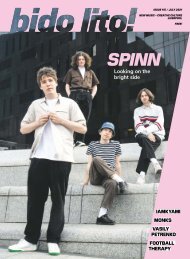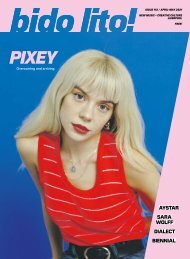Issue 35 / July 2013
July 2013 issue of Bido Lito! Featuring AMIQUE, TWO SUNSETS, SUGARMEN, THE PHARCYDE and much more.
July 2013 issue of Bido Lito! Featuring AMIQUE, TWO SUNSETS, SUGARMEN, THE PHARCYDE and much more.
You also want an ePaper? Increase the reach of your titles
YUMPU automatically turns print PDFs into web optimized ePapers that Google loves.
10<br />
Bido Lito!<br />
<strong>July</strong> <strong>2013</strong><br />
Words: Jessie Main / @JessieMainMusic<br />
Illustration: Garreth Gibson / @garrethgibson<br />
The KLF’s Bill Drummond and Jimmy Cauty (aka The Timelords)<br />
demonstrated their true genius when it emerged that other artists<br />
had been successful in utilising their almanac The Manual (How<br />
To Have A Number One The Easy Way) to break into the charts. The<br />
anarchists’ project perfectly illustrated the flaws in the industry,<br />
showing how, with the right line of attack, really anyone could<br />
make it to the top spot, without money or musical skills. Their labrat<br />
was a horrendous self-proclaimed meaningless landmark of<br />
shite based on the Doctor Who theme tune, and it was as glorious<br />
as it was demoralising. Amongst their explicit instructions on how<br />
to approach the industry big wigs, lifestyle advice - “first you must<br />
be skint and on the dole” - and tools needed for the job, lie the<br />
“Golden Rules”. The Manual was written in 1988, but these still<br />
make for a fairly frustrating read:<br />
“Firstly, it has to have a dance groove that will run all the way<br />
through the record and that the current 7” buying generation<br />
will find irresistible. Secondly, it must be no longer than three<br />
minutes and thirty seconds (just under 3’20” is preferable). If they<br />
are any longer Radio 1 daytime DJs will start fading early or talking<br />
over the end, when the chorus is finally being hammered home<br />
– the most important part of any record. Thirdly, it must consist<br />
of an intro, a verse, a chorus, second verse, a second chorus, a<br />
breakdown section, back into a double length chorus and outro.<br />
Fourthly, lyrics. You will need some, but not many.”<br />
It’s 25 years old,<br />
but still pretty depressingly<br />
‘on<br />
the<br />
money’,<br />
as it<br />
were. It showcases the naked truth of the lucrative pop song’s<br />
building blocks, viscerally geared towards the quantifiable success<br />
story. As a method it is not indicative of emotions or experience,<br />
instead it emphasises the feeding of our ears with a formula that<br />
has ‘worked’ for at least the past quarter of a century, if not since<br />
the advent of pop music. It is a sign of the perpetual cycle that<br />
means pop music is littered with the same ideas over and over<br />
again. The famed music journalist David Quantick touched on<br />
this idea, ultimately coining the phrase ‘pop will eat itself’, after<br />
which the group formerly known as Wild And Wandering renamed<br />
themselves. And we don’t have to look far to see examples. In Rob<br />
Paravonian’s Pachelbel Rant, (which can be found on YouTube) the<br />
comedian laments the repetitive cello line in Pachelbel’s Canon<br />
in D following him. It highlights the sheer number of pop songs<br />
based on that chord progression, something I’m not sure our<br />
mate Johann could have ever predicted back in the 1700s.<br />
It’s not just ‘pop’ that is implicated: our western tonal system<br />
has been used for literally hundreds of years, and most ‘popular’<br />
(that is, not classical) genres tend to showcase tracks under five<br />
minutes long that stick to one major or minor key. Are we not<br />
eventually going to run out of anything completely original? Have<br />
we already done so? Are we not just swallowing and regurgitating<br />
ideas like cows chewing the cud, coughing up the same mulch<br />
again and again, which we’ll eventually have to gulp down for<br />
good, leaving nothing but malnutrition and a bitter<br />
aftertaste? The cows will eventually move on<br />
to fresh pastures – and we must do the<br />
same. Who was the last artist to<br />
sound like no other before, and<br />
also have a profound effect on<br />
all who came<br />
after?<br />
There isn’t a priority to sound like no other before. On the<br />
contrary, musicians are proud to list the artists who have influenced<br />
them. Taking inspiration external to the formula means that there<br />
is potential for an array of variations. One thing the Pachelbel<br />
rant does show is that, given four chords, different people will<br />
come up with vastly different ideas. Maybe not entirely original<br />
sounding, but different.<br />
Perhaps a more aligned and less shoot-a-stake-through-myheart-I-can’t-listen-to-this-crap-anymore<br />
example is the rich<br />
tradition of the blues – a whole genre based on the same or a<br />
similar chord progression, which yet has a plethora of emotion<br />
and real experience running through it.<br />
“So why don’t all songs sound the same?” ask the KLF. “Why<br />
are some artists great, write dozens of classics that move you<br />
to tears, say it like it’s never been said before, make you laugh,<br />
dance, blow your mind, fall in love, take to the streets and riot?<br />
Well, it’s because although the chords, notes, harmonies, beats<br />
and words have all been used before, their own soul shines<br />
through; their personality demands attention.”<br />
To an outsider, perhaps it does sound the same. But maybe<br />
that’s OK. I think the familiarity of popular music doesn’t detract<br />
from its value. I’m not saying when it comes to manufactured<br />
pop one should find meaning that isn’t there in what is<br />
usually a guilty pleasure. But instead, like the arse-coloured<br />
misery paste that is eventually served up to us in the form of<br />
Chicken McNuggets, perhaps some kind of originality lies in the<br />
experience of consumption. The elements of the composition<br />
are pretty much identical, but our experience is slightly different<br />
every time, depending on where we are in life, or even what<br />
else we have consumed that day. The product is serving a<br />
certain purpose and is serving it well. I love McNuggets, but not<br />
in the same way I love foie gras or, say, The National. And, as<br />
that tenuous analogy starts to lose its legs, within music<br />
that inspires us the quest for originality turns in on itself –<br />
what we’re actually listening out for is music that keeps us<br />
feeling, that speaks to us.<br />
The likelihood is that we are always going to be subjected to<br />
what the Radio 1 Chart show can spit out, with the perpetrators<br />
gleaning little pieces of ‘sellable’ information each time. As we<br />
evolve, they will produce music that reacts well with the<br />
taste buds of the masses. They always have done.<br />
Luckily, in our city and so many others, in communityrun<br />
music venues, in garages, in warehouses, in<br />
bedrooms, or in my case in the shower, there are people<br />
pouring new experiences into the music they write, using<br />
the language of tonality to manifest their uniqueness.<br />
Unable to provide a phrasebook to everyone listening,<br />
writers leave their work open to the interpretation of<br />
the varied complicated lives of music lovers.<br />
And it’s happening with all genres,<br />
even the ones that come out<br />
sounding like pop.<br />
Gig Guide and Ticket Shop live at www.bidolito.co.uk


















